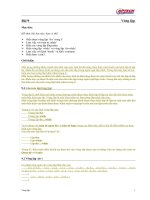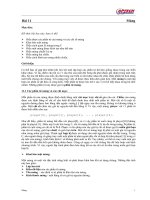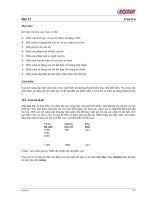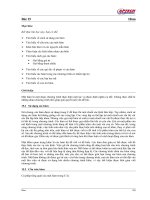Computer concept 2018 module01
Bạn đang xem bản rút gọn của tài liệu. Xem và tải ngay bản đầy đủ của tài liệu tại đây (3.3 MB, 102 trang )
Computer Concepts 2018
Module 1
Digital Content
Copyright © 2019 Cengage. All rights reserved.
Module Contents
•
•
•
•
•
Section A: Digital Basics
Section B: Digital Sound
Section C: Bitmap Graphics
Section D: Vector Graphics
Section E: Digital Video
Copyright © 2019 Cengage. All rights reserved.
Section A: Digital Basics
•
•
•
•
•
Data Representation Basics
Representing Numbers
Representing Text
Bits and Bytes
Compression
Copyright © 2019 Cengage. All rights reserved.
Section A: Objectives (1 of 2)
•
•
•
•
List three technologies that digital devices use to physically store or transmit 1s and 0s
Write the numbers 1 through 10 in binary
Decipher ASCII text
Demonstrate how to use the terms bit, byte, megabyte, megabit, and gigabyte in the context of
data storage and digital devices
Copyright © 2019 Cengage. All rights reserved.
Section A: Objectives (2 of 2)
•
Distinguish between data that would be represented by binary numbers and data that would be
represented by ASCII or Unicode
•
•
•
Explain how OCR relates to ASCII and Unicode
Describe the difference between lossy and lossless compression
Demonstrate how to compress a file
Copyright © 2019 Cengage. All rights reserved.
Data Representation Basics (1 of 4)
•
•
•
Data refers to the symbols that represent people, events, things, and ideas. Data can be a name,
a number, the colors in a photograph, or the notes in a musical composition
Data Representation refers to the form in which data is stored, processed, and transmitted
Devices such as smartphones, iPods, and computers store data in digital formats that can be
handled by electronic circuitry
Copyright © 2019 Cengage. All rights reserved.
Data Representation Basics (2 of 4)
•
•
Digitization is the process of converting information, such as text, numbers, photo, or music, into
digital data that can be manipulated by electronic devices
The digital revolution has evolved through four phases, beginning with big, expensive, standalone
computers, and progressing to today’s digital world in which small, inexpensive digital devices are
everywhere
Copyright © 2019 Cengage. All rights reserved.
Data Representation Basics (3 of 4)
•
•
•
The 0s and 1s used to represent digital data are referred to as binary digits — from this term we
get the word bit that stands for binary digit
A bit is a 0 or 1 used in the digital representation of data
A digital file, usually referred to simply as a file, is a named collection of data that exits on a
storage medium, such as a hard disk, CD, DVD, or flash drive
Copyright © 2019 Cengage. All rights reserved.
Data Representation Basics (4 of 4)
Copyright © 2019 Cengage. All rights reserved.
Representing Numbers (1 of 2)
•
•
•
•
Numeric data consists of numbers that can be used in arithmetic operations
Digital devices represent numeric data using the binary number system, also called base 2
The binary number system only has two digits: 0 and 1
No numeral like 2 exists in the system, so the number “two” is represented in binary as 10
(pronounced “one zero”)
Copyright © 2019 Cengage. All rights reserved.
Representing Numbers (2 of 2)
DECIMAL (BASE 10)
BINARY (BASE 2)
0
0
1
1
2
10
3
11
4
100
5
101
6
110
7
111
8
1000
9
1001
10
1010
11
1011
1000
1111101000
Copyright © 2019 Cengage. All rights reserved.
Representing Text (1 of 9)
•
•
•
Character data is composed of letters, symbols, and numerals that are not used in calculations
Examples of character data include your name, address, and hair color
Character data is commonly referred to as “text”
Copyright © 2019 Cengage. All rights reserved.
Representing Text (2 of 9)
•
Digital devices employ several types of codes to represent character data, including ASCII,
Unicode, and their variants
•
ASCII (American Standard Code for Information Interchange, pronounced “ASK ee”) requires
seven bits for each character
•
The ASCII code for an uppercase A is 1000001
Copyright © 2019 Cengage. All rights reserved.
Representing Text (3 of 9)
•
•
•
Extended ASCII is a superset of ASCII that uses eight bits for each character
For example, Extended ASCII represents the uppercase letter A as 01000001
Using eight bits instead of seven bits allows Extended ASCII to provide codes for 256 characters
Copyright © 2019 Cengage. All rights reserved.
Representing Text (4 of 9)
•
•
•
Unicode (pronounced “YOU ni code”) uses sixteen bits and provides codes or 65,000 characters
This is a bonus for representing the alphabets of multiple languages
UTF-8 is a variable-length coding scheme that uses seven bits for common ASCII characters but
uses sixteen-bit Unicode as necessary
Copyright © 2019 Cengage. All rights reserved.
Representing Text (5 of 9)
00100000
Space
00110011
3
01000110
F
01011001
Y
01101100
l
00100001
!
00110100
4
01000111
G
01011010
Z
01101101
m
00100010
"
00110101
5
01001000
H
01011011
[
01101110
n
00100011
#
00110110
6
01001001
I
01011100
\
01101111
o
00100100
$
00110111
7
01001010
J
01011101
]
01110000
p
00100101
%
00111000
8
01001011
K
01011110
^
01110001
q
00100110
&
00111001
9
01001100
L
01011111
_
01110010
r
00100111
'
00111010
:
01001101
M
01100000
`
01110011
s
00101000
(
00111011
;
01001110
N
01100001
a
01110100
t
00101001
)
00111100
<
01001111
O
01100010
b
01110101
u
00101010
*
00111101
=
01010000
P
01100011
c
01110110
v
00101011
+
00111110
>
01010001
Q
01100100
d
01110111
w
00101100
,
00111111
?
01010010
R
01100101
e
01111000
x
00101101
-
01000000
@
01010011
S
01100110
f
01111001
y
00101110
.
01000001
A
01010100
T
01100111
g
01111010
z
00101111
/
01000010
B
01010101
U
01101000
h
01111011
{
00110000
0
01000011
C
01010110
V
01101001
i
01111100
|
00110001
1
01000100
D
01010111
W
01101010
j
01111101
}
00110010
2
01000101
E
01011000
X
01101011
k
01111110
~
Copyright © 2019 Cengage. All rights reserved.
Representing Text (6 of 9)
•
•
ASCII codes are used for numerals, such as Social Security numbers and phone numbers
•
On Apple devices these files are labeled “Plain Text.” In Windows, these files are labeled “Text
Document”
Plain, unformatted text is sometimes called ASCII text and is stored in a so-called text file with a
name ending in .txt
Copyright © 2019 Cengage. All rights reserved.
Representing Text (7 of 9)
•
•
ASCII text files contain no formatting
To create documents with styles and formats, formatting codes have to be embedded in the text
Copyright © 2019 Cengage. All rights reserved.
Representing Text (8 of 9)
•
•
•
•
Microsoft Word produces formatted text and creates documents in DOCX format
Apple Pages produces documents in PAGES format
Adobe Acrobat produces documents in PDF format
HTML markup language used for Web pages produces documents in HTML format
Copyright © 2019 Cengage. All rights reserved.
Representing Text (9 of 9)
Copyright © 2019 Cengage. All rights reserved.
Bits and Bytes (1 of 5)
•
•
All of the data stored and transmitted by digital devices is encoded as bits
•
•
The word bit, an abbreviation for binary digit, can be further abbreviated as a lowercase b
Terminology related to bits and bytes is extensively used to describe storage capacity and
network access speed
A group of eight bits is called a byte and is usually abbreviated as an uppercase B
Copyright © 2019 Cengage. All rights reserved.
Bits and Bytes (2 of 5)
•
When reading about digital devices, you’ll frequently encounter references such as 90 kilobits per
second, 1.44 megabytes, 2.8 gigahertz, and 2 terabytes
•
Kilo, mega, giga, tera, and similar terms are used to quantify digital data
Copyright © 2019 Cengage. All rights reserved.
Bits and Bytes (3 of 5)
Bit
One binary digit
Byte
8 bits
Kilobit
10
1,024 or 2 bits
Kilobyte
10
1,024 or 2 bytes
Megabit
1,048,576 or 2
Megabyte
1,048,576 or 2
Gigabit
2
Gigabyte
2
Terabyte
2
Petabyte
2
Exabyte
2
30
30
40
50
60
20
20
bits
bytes
bits
bytes
bytes
bytes
bytes
Copyright © 2019 Cengage. All rights reserved.
Bits and Bytes (4 of 5)
•
•
•
Use bits for data rates, such as Internet connection speeds, and movie download speeds
Use bytes for file sizes and storage capacities
56 Kbps: Kilobit (Kb or Kbit) can be used for slow data rates, such as a 56 Kbps (kilobits per second)
dial-up connection.
•
•
104 KB: Kilobyte (KB or Kbyte) is often used when referring to the size of small computer files.
50 Mbps: Megabit (Mb or Mbit) is used for faster data rates, such as a 50 Mbps (megabits per second)
Internet connection.
Copyright © 2019 Cengage. All rights reserved.
Bits and Bytes (5 of 5)
•
3.2 MB: Megabyte (MB or MByte) is typically used when referring to the size of files containing
photos and videos.
•
•
100 Gbit: Gigabit (Gb or Gbit) is used for really fast network speeds.
16 GB: Gigabyte (GB or GByte) is commonly used to refer to storage capacity.
Copyright © 2019 Cengage. All rights reserved.









